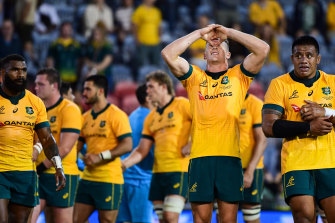Why is rugby so scared of going back to its roots?
Each week, the biggest noise in my suburb – bigger than all the construction, traffic, thunder and every dog barking together – is made by amateur sport. It’s the guttural roar of afternoon crowds gathering to watch rugby. Subbies, school, club; it doesn’t matter. They go nuts.
Amateur rugby, the grassroots, is generally agreed to be the code’s strongpoint. Those roars and cheers are so loud, they draw you in to see what’s going on. You might watch for a while and take an interest in the game. If it was on subscription TV, you might even pay for it.
Rugby Australia chairman Hamish McLennan unveiled a loss of $27 million in the past year this week.Credit:Nick Moir
Yet amateurism, strangely, also carries such a stigma that the code’s governing body revealed this week what extraordinary lengths it has gone to, and will go to, in order to stop its elite level from slipping back to that same amateur status.
Hamish McLennan, the chairman of Rugby Australia, unveiled a loss of $27 million in the past year. Almost $46 million of revenue was foregone due to COVID-enforced cancellations of Test matches and tours. To cover for it, the new administration managed to cut $31.2 million in costs (to which the average punter scratched their head and asked what the hell rugby was spending a cuttable $31.2 million on).
That was only the first of the uncomfortable truths. How was the lost revenue replaced? The Australian taxpayer helped out with grants, and the code obtained loans of $14.2 million from World Rugby and $6.9 million from the bank HSBC so that its professional level could stay solvent.
But wait – sadly – there’s more. McLennan forecast, with refreshing honesty, the regrettable prospect of selling, if not the farm then a couple of back paddocks and the equipment shed, to private equity. New Zealand has already done this, flogging off one-eighth of its commercial potential to the American private equity group Silver Lake. New Zealand hailed this deal, Eddie McGuire-style, as if it was a great day for rugby. Australia was more candidly, and commendably, sheepish.
Rugby Australia’s poor financial position is cause for concern.Credit:Stuart Walmsley/Rugby AU
Private ownership has never had a particularly high reputation in sports where clubs or entities represent communities. Private owners sometimes step in as funders of last resort, and at best are regarded as temporary saviours or good Samaritans. Eventually, though, there is a public moral limit on how far and how long they will go, a spirit that some private owners struggle to comprehend. Private ownership over what supporters deem to be “their” teams seldom ends well, and in European football we’ve seen that even when it produces untold revenue, it still doesn’t end well.
Aware that “private” and “equity” are currently a pair of dirty words, McLennan was at least decent enough to express reluctance to seek cash from private sources. Unlike some of his predecessors, his public utterances are more attuned to the sentiments of the real rugby community than to the (lack of) sentiments of hardheads in suits.
It was a humbling moment for the code. It’s not that the Wallabies have been sold off (so far), but, through debt and a transfer of ownership, a portion of whatever financial recovery they make in coming years has been signed away.
I wouldn’t doubt for a moment that this follows well-informed business logic. They know a lot better than I do. But when you hear and see the exuberance that comes out of amateur rugby, it would be remiss not to ask if mortgaging the house to save the silver is all worth it.
There’s an alternative universe in which rugby accepts this fate, rather than seeing a pause, a temporary reversion to amateurism, as utter failure.
“When I came on board in June-July,” McLennan said, “had we not been able to get cost out of the business and get some certainty into some of our revenue numbers, we openly talked about the game potentially becoming amateur.” There was no questioning the assumption that this would have been a fate worse than death. “It was a real possibility,” he said. “It wasn’t just idle talk.”
There’s an alternative universe in which rugby accepts this fate, rather than seeing a pause, a temporary reversion to amateurism, as utter failure. In this version, what happens? Professional players go to Japan and elsewhere to make a living until professional Australian rugby is back on its feet. True, its most talented youngsters, if they want to play for money, head for rugby league. But most are doing that anyway. Rugby Australia finds it can cut even more than $31.2 million from its costs. It lives within its means, rather than borrowing against its future. Its foundation remains secure, a solid floor to bounce back off. For a year, it has to go into cold storage. Employees go and get real jobs. Meanwhile, amateur rugby continues to flower in the suburbs and schools.
The professional version of rugby, only 25 years old and featuring a relative handful of players, is so precious that the rest of the game had to go into hock to preserve it. Of course that was what they had to do. But the alternative is worth contemplating as we watch, this weekend, the finals of those two furniture-saving exercises, Super Rugby AU and Aotearoa. Both provincial competitions have run on fumes, doing as well as they possibly can, for two seasons. But let’s hope that Saturday night bids goodbye, farewell and amen to enforced isolation.
It’s as hard to judge the standard as it is in any internal shirts-versus-skins trial. Some enlightenment will come during the trans-Tasman provincial competition this month. The Waratahs will find there is more dignity in being thumped by Kiwi teams than by fellow Australians. Yet, as anyone watching the recent Six Nations championship would have intuited, both New Zealand and Australia are slipping further behind with each year of isolation. Just as insularity has been Australia’s and New Zealand’s greatest friend in warding off COVID-19, it’s their greatest liability in just about every other way. Fortress Australia swiftly becomes Fortress NSW becomes Fortress My Place. It’s two sides of the same coin: saving lives entails a shrunken idea of home. While this does relatively little harm to inherently inward-looking codes – such as NRL and AFL – rugby is interlocked with the world and can only suffer from insularity.
But whatever works, right? Beggars can’t be choosers. There are signs of life in Stan Sport’s claim of securing 150,000 new subscribers. If there are that many rugby followers out there, Stan has done very well to locate every one of them and their mothers too. It does, of course, abet the hope that if the game can get through the current crisis, there is a gigantic rebound waiting.
When the rebound comes, will professional rugby in Australia be ready for it, or will it be too hobbled by what it has had to do to stay alive? The choice was unpalatable. But amateurism is good enough for the suburbs and schools and, lest we forget, it’s good enough for women players. It is only for a tiny slice of male rugby at the top of the pyramid that so much sacrifice was made.
There’s something intriguing in this, and it’s not the soppy sentimentality of extolling the old amateur spirit for its own sake. It’s an old-fashioned and naive notion that a game might choose to contract with its circumstances, and have faith in its heartland appeal over the long term; to believe that it will keep going because its community loves it. This, poignantly, was a risk the game’s leaders could not afford to take.
Sport newsletter
Sports news, results and expert commentary delivered straight to your inbox each weekday. Sign up here.
Most Viewed in Sport
From our partners
Source: Read Full Article


